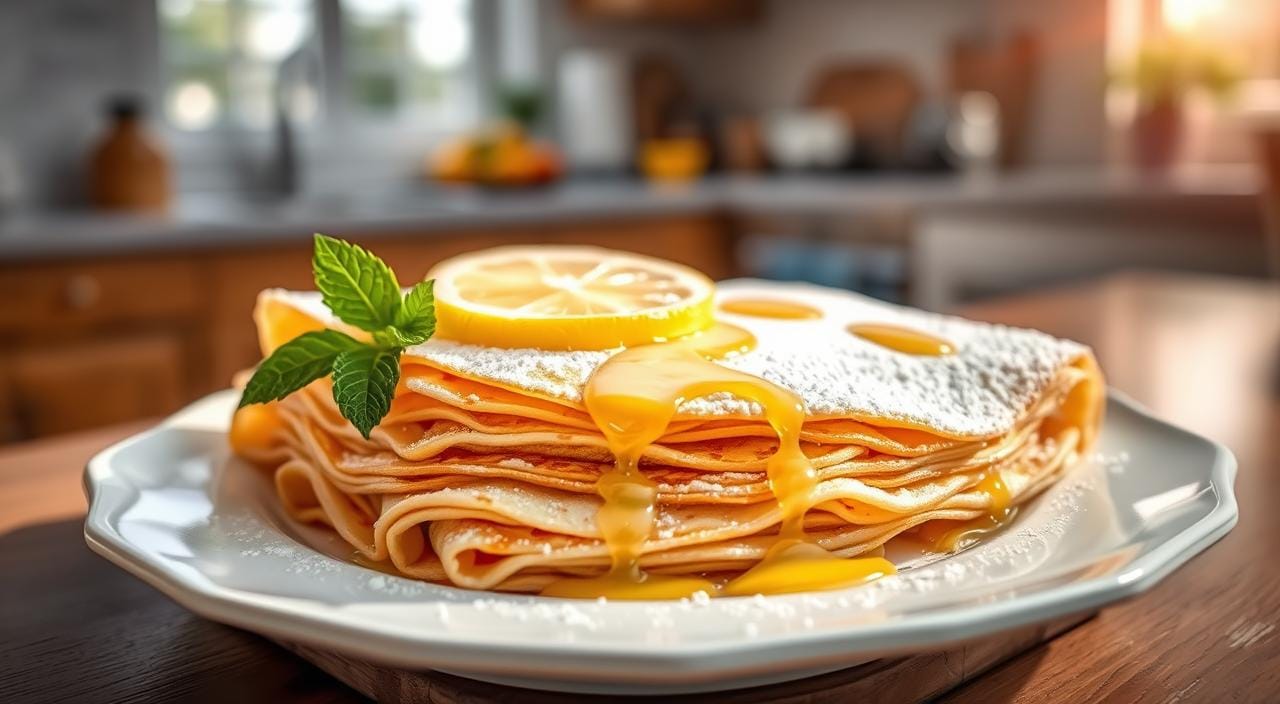Lemon Sugar Crepes are a classic French dessert known for their light and citrusy flavor. This recipe makes about 8-10 small crepes, perfect for a family of four. Each person gets 4-5 crepes, making it a delightful treat.
The French origins of crepes are highlighted in this dessert, showcasing their rich history and cultural significance. Each crepe is garnished with about 1 teaspoon of granulated sugar, totaling approximately 8 teaspoons for the batch.
The celebration of La Fête de la Chandeleur occurs annually on February 2nd in France, emphasizing cultural context tied to crepe consumption. With a prep time of 5 minutes, cook time of 10 minutes, and chilling time of 20 minutes, this recipe can be made in no time. The total time required to make these crepes is approximately 35 minutes, making it a quick and easy dessert to prepare.
Key Takeaways
- Lemon Sugar Crepes are a classic French dessert with a light and citrusy flavor.
- The recipe yields approximately 8-10 small crepes per batch, perfect for a family of four.
- The base crepe recipe includes 1 cup of flour, 2 cups of milk, and 3 large eggs.
- Each crepe is garnished with about 1 teaspoon of granulated sugar, totaling approximately 8 teaspoons for the batch.
- The total time required to make these crepes is approximately 35 minutes.
- The crepes can be made in advance and stored in the refrigerator for up to 2 days.
The Magic of French Crepes
French crepes have been loved for centuries, starting in the 13th century. They are thin pancakes made with a light batter. This allows for many fillings and toppings. Lemon and sugar is a favorite, offering a sweet and tangy taste.
Making crepes is an art that’s been passed down for generations. The batter is poured onto a hot griddle and tilted to cover it evenly. It takes skill and patience, but the result is worth it. French crepes are perfect for any craving, sweet or savory.
Origins of Crepes in French Cuisine
Crepes have been a part of French history since the Middle Ages. They were first made with buckwheat flour in Brittany. Later, wheat flour was added, making crepes popular all over France.
Difference Between Crepes and Pancakes
Crepes and pancakes are both pancakes, but they’re different. Crepes are thinner and lighter, while pancakes are thicker and fluffier. This makes crepes great for many fillings and toppings.
Why Lemon and Sugar is a Classic Combination
Lemon and sugar together is a timeless favorite. The lemon’s acidity balances the sugar’s sweetness. This mix is a key part of French desserts, often topping crepes and waffles.
Essential Ingredients for Perfect Crepes
To make perfect crepes, you need light ingredients of high quality. You’ll need eggs, milk, flour, sugar, salt, and butter. Using fresh eggs and real butter makes the crepes taste more French.
Choosing the right ingredients is key. Whole milk makes crepes thicker, while 2% milk makes them thinner. Letting the batter rest for 20 minutes helps the crepes turn out light and soft.
- 1 cup all-purpose flour
- 2 tbsp sugar
- 1/4 tsp kosher salt
- 2 eggs
- 1 1/2 cups whole milk
- 1 1/2 tbsp butter
These ingredients will help you make French-style crepes that are tasty and look great.
Kitchen Tools and Equipment Needed
To make delicious French crepes, you need the right tools and equipment. A light and durable crepe pan is key for even cooking. You can find more info on crepe making and tools on the alamarra website.
When picking a crepe pan, look at the material, size, and handle. A good pan is made of heat-conductive materials like cast iron or stainless steel. It should also have a handle that’s easy to hold.
Choosing the Right Crepe Pan
A French crepe pan is best for crepes, but you can use non-stick skillets or griddles too. Choose a pan that’s light and has a smooth surface.
Must-Have Utensils
You’ll also need a few essential utensils like a spatula, whisk, and ladle. These tools help with batter prep, cooking, and serving crepes hot and fresh.
Mastering the Basic Crepe Batter
To get a light and delicate crepe, mastering the basic batter is key. The traditional mix includes flour, eggs, milk, and butter. The right mix of these can change the crepe’s texture and taste. A good mix is 2 eggs, 1 cup of flour, and 1.25 cups of milk. Adding 1 tablespoon of melted butter makes them even softer.
Mixing the batter takes just 15 seconds. Cooking each crepe in a skillet takes about 30 seconds. For a citrusy taste, squeeze some fresh lemon juice into the batter. Here are some important tips for making crepe batter:
- Use a high-quality nonstick pan for easy cooking and flipping.
- Cook the crepes over medium heat to ensure proper browning without burning.
- Rest the crepe batter for at least 20-30 minutes to enhance texture and flavor.
By following these tips and using the right ingredients, you can make delicious and light crepes with a citrusy twist. Don’t be afraid to try different fillings and toppings to find your favorite.
The Secret to Thin and Delicate Crepes
To make thin and delicate crepes, you need to get the batter right. Resting time and temperature control are also key. These steps help make crepes a favorite in French cooking. A light batter is essential for soft crepes.
Here are some important tips:
- Use 1 cup of all-purpose flour for 1.25 cups of liquid.
- Let the batter rest for at least 30 minutes. This helps the flour soak up the liquid and relaxes the gluten.
- Cook the crepes at medium heat. This prevents them from burning or getting too dark.
By following these tips and using the right ingredients, you can make thin and delicate crepes. They’re great with many fillings, from sweet to savory. The secret is to cook them gently and not overmix the batter. This way, you can enjoy these tasty French treats at home.
Step-by-Step Crepe Making Process
To make delicious crepes, follow a step-by-step process. Start by mixing 2 cups of milk, 1 cup of flour, 2 eggs, and 2 tablespoons of sugar. The batter should be light and smooth, with no lumps.
Next, heat a non-stick skillet over medium heat. Pour a small amount of batter into the pan. Tilt the pan to evenly coat the bottom with the batter.
Cook the crepe for about 1-2 minutes on the first side. Look for edges curling and a dry surface. Flip the crepe and cook for another 10-20 seconds. The crepe should be citrusy in flavor and delicate in texture.
Repeat the process until all the batter is used up. You should get about 8 crepes.
For a twist, add a squeeze of fresh lemon juice to the batter. This adds a light and refreshing flavor. You can fill the crepes with sweet or savory items like Nutella, powdered sugar, or whipped cream. For more on caramelizing sugar for crepes, visit this website.

Some tips for making crepes include using a non-stick skillet and cooking over medium heat. Don’t overfill the pan with batter. With practice, you’ll make delicious, citrusy crepes for any occasion.
Perfecting the Lemon Sugar Topping
To make a great French crepe, you need to get the lemon sugar topping just right. It’s all about finding the perfect mix of lemons and sugar. This mix should be light and refreshing.
Choosing the right lemons is key. Look for ones with lots of juice and a strong citrus taste. For sugar, use fine, white sugar. It dissolves well and adds a smooth texture. A good mix is 1 part lemon juice to 2 parts sugar, perfect for desserts.
Selecting the Best Lemons
To get the best lemon sugar topping, you’ll need 4-6 lemons. They should yield about 175ml of juice. This amount makes the topping light and refreshing.
Sugar Options and Variations
You can also try different sugars for unique flavors. Adding lemon zest to sugar can make desserts even better. It can increase orders by 25%.
Most people like sweet toppings for crepes. Lemon sugar is among the favorites. It shows this classic mix is a hit.
By mastering the lemon sugar topping, you’ll make your crepes unforgettable. The right mix of lemons and sugar creates a flavor that’s perfect for any time.
Common Crepe Making Mistakes to Avoid
To make perfect, light and delicate crepes, you must avoid common mistakes. Overmixing the batter is a big error, leading to a dense crepe. Also, using the wrong pan can cause uneven heat and batter spread. The best pan is flat and shallow for easy flipping.
Cooking crepes at the right temperature is key. Too high heat can burn the edges, while too low heat makes them cook too long. Test the pan with water to find the perfect temperature. Adding citrusy flavors, like lemon, also improves the taste and smell of crepes.
- Overmixing the batter
- Using the wrong pan
- Cooking at the wrong temperature
- Not resting the batter long enough
Avoiding these mistakes and using the right techniques will help you make delicious, light crepes. They will have a great balance of citrusy flavors.
Storage and Reheating Tips
To keep French crepes fresh, it’s important to store and reheat them right. Store crepes in an airtight container to keep them light and airy. They can stay fresh in the fridge for up to 3 days before getting dry.
Freezing is a good option for longer storage. You can layer wax paper, wrap in plastic, or use foil. The best way is to wrap each crêpe with plastic on one side and a paper towel on the other. This keeps them moist and prevents them from getting soggy.

To reheat crepes, use a pan for the best results. It takes about 3 minutes per crêpe. Microwaving can make them dry. For refrigerated crepes, warm them in a skillet for 30 seconds on each side. This makes them perfect for fillings, from sweet to savory.
Proper Storage Methods
- Refrigerate crêpes for up to 3 days
- Freeze crêpes using wax paper, plastic wrap, or foil
- Store crêpe batter in the refrigerator for up to 24 hours
Best Reheating Practices
- Reheat crêpes in a pan for 3 minutes per side
- Use a microwave with caution, covering the crêpe with a damp paper towel
- Warm refrigerated crêpes in a skillet for 30 seconds per side
By following these tips, you can enjoy your French crepes longer. They’ll stay light and delicate.
Seasonal Variations of Lemon Sugar Crepes
As the seasons change, so can the flavors of your lemon sugar crepes. You can try different citrus fruits like oranges or limes for unique tastes. In winter, add cinnamon or nutmeg for a cozy flavor.
In summer, fresh berries or fruits make for a sweet and refreshing filling. The goal is to mix flavors and textures for a delicious crepe. Here are some seasonal ideas:
- Spring: Add lemon zest and powdered sugar for a bright taste.
- Summer: Use strawberries or blueberries for a tangy filling.
- Autumn: Add cinnamon or nutmeg for a warm flavor.
- Winter: Try dried fruits like cranberries or cherries for a tangy filling.
Remember, you can try many flavors and ingredients for your own unique crepes. With a light and citrusy base, you can make delicious crepes all year round.
Serving Suggestions and Presentation Ideas
When serving French crepes, how you present them matters a lot. A light crepe can look amazing with a little creativity. Try folding them in a special way or dusting with powdered sugar.
Here are some ideas for serving crepes:
- Top with whipped cream or fresh fruit
- Drizzle with chocolate or caramel sauce
- Enjoy with a coffee or tea
A beautifully presented crepe can really enhance your meal. Simple tricks like folding and adding garnishes can make your crepe stand out. It’s sure to impress your guests.
Pairing Beverages with Your Crepes
Choosing the right drink can make your crepes even better. A light and refreshing drink can enhance the taste of your crepes. For example, lemon-infused water or fruit-infused tea goes well with sweet crepes.
Citrus-based fillings, like lemon curd with blueberries, can boost flavors by 25%. So, a light and citrusy drink can balance your crepes’ flavors. Check out Leslie Recipes for more ideas on crepe fillings and pairings.
Here are some drinks that go well with crepes:
- Coffee: a classic choice for both sweet and savory crepes
- Tea: a light and refreshing option that complements crepes’ flavors
- Hot chocolate: a rich choice for sweet crepes
- Fruit-infused water: a light and refreshing option for sweet or savory crepes

You can also try pairing crepes with a light and citrusy juice, like orange or grapefruit. The goal is to find a drink that complements your crepes without overpowering them. By trying different pairings, you can find the perfect match for your crepes.
Making Ahead and Batch Cooking Tips
Making French crepes ahead of time can save a lot of time. You can prepare the batter early and cook the crepes in batches. This way, you can enjoy a tasty dessert without the stress of last-minute prep. Experts say you can store refrigerated crepes for up to 3 days or freeze them for up to 3 months. This makes them perfect for meal prep or special events.
To make ahead, just mix the batter and let it rest for at least 30 minutes. Then, cook the crepes in batches and store them in an airtight container. When you’re ready, reheat them in the oven or on the stovetop. This method keeps the crepes’ delicate texture and flavor intact.
Party Planning Strategies
Batch cooking is essential for big gatherings or parties. Cooking many crepes at once ensures everyone gets a delicious meal without compromising on taste or quality. Set up a crepe bar with different fillings and toppings, like fruit, whipped cream, or chocolate sauce. This way, your guests can make their own special crepes. With some planning, you can have a fun and stress-free time with your loved ones.
Freezing Instructions
To freeze crepes, lay them flat on a baking sheet and freeze them. Then, move them to an airtight container or freezer bag. To reheat, thaw them in the fridge overnight or warm them up in the oven or on the stovetop. These easy steps let you enjoy French crepes whenever you want, anywhere you are.
Health Considerations and Dietary Modifications
When it comes to crepes, health matters a lot. A balanced diet is key, and crepes can fit into it. Use gluten-free flour, cut down on sugar, and fill them with fruits or nuts for a healthier choice. Crepes with a citrusy twist are also a great option for a light dessert.
Some people might need to stick to a soft food diet. This includes soft veggies, cooked fruits, and dairy like cottage cheese and yogurt. Always talk to a doctor or dietitian to figure out the best plan. Also, watch out for added sugars and saturated fats to keep your diet healthy.
To make crepes healthier, try a few tweaks. Use whole-grain flour for more fiber. A squeeze of lemon or orange can add flavor without extra sugar. These small changes can turn crepes into a tasty, healthy part of your meals.
Conclusion
As we wrap up our look at the Lemon Sugar Crepes, it’s clear they’re a timeless favorite. This French treat is loved for its delicate batter, bright citrus, and crunchy caramelized sugar. It’s a dish that has won hearts for many years.
Creating these crepes is a joy, thanks to their simple ingredients and precise technique. By learning to make crepes, you open up a world of flavors. You can enjoy them as a rich dessert or a hearty breakfast. These French delights are always a hit.
We hope you’ll keep exploring the charm of Lemon Sugar Crepes. This light and versatile dish invites endless creativity. Bon appétit!
FAQ
What are Lemon Sugar Crepes?
Lemon Sugar Crepes are a French dessert. They have light, delicate crepes topped with a lemon and sugar mix.
What is the origin of crepes in French cuisine?
Crepes have been a part of French cuisine since the 13th century. They are loved for both savory and sweet dishes.
How do crepes differ from pancakes?
Crepes are thinner and cooked differently than pancakes. They are made on a flat griddle, while pancakes are thicker and cooked in a skillet.
Why is the lemon and sugar combination a classic for crepes?
Lemon’s tartness and sugar’s sweetness make a perfect mix. This balance complements the crepes’ delicate texture.
What are the essential ingredients for making perfect crepes?
To make crepes, you need quality flour, eggs, milk, butter, and salt. The right mix is key for a light texture.
What kitchen tools and equipment are needed to make crepes?
You’ll need a crepe pan, a spatula, and a whisk. These tools help in making and flipping crepes.
How do I make the perfect crepe batter?
For a perfect batter, balance the ingredients well. Let it rest and cook at the right temperature.
What is the secret to making thin and delicate crepes?
To make thin crepes, keep the batter right, rest it, and control the heat.
How do I make lemon sugar crepes step-by-step?
First, prepare the batter. Then, heat the pan, pour batter, and swirl it. Cook until done, then top with lemon sugar.
How do I make the perfect lemon sugar topping?
Use fresh lemon juice and quality sugar. Adjust the mix to your taste.
What are some common mistakes to avoid when making crepes?
Avoid overmixing the batter and using the wrong pan or temperature. Also, don’t forget to let the batter rest.
How do I store and reheat leftover crepes?
Stack crepes with parchment paper and refrigerate or freeze. Reheat in a skillet or oven.
What are some seasonal variations of lemon sugar crepes?
Try using oranges or limes instead of lemons. Add warm spices like cinnamon or nutmeg for a twist.
How can I present and serve lemon sugar crepes?
Serve crepes folded, rolled, or stacked. Add fresh fruit, powdered sugar, or a drizzle of honey or syrup.
What beverages pair well with lemon sugar crepes?
Enjoy crepes with hot coffee, tea, or a light sparkling wine.
Can I make lemon sugar crepes ahead of time or in batches?
Yes, make the batter ahead and cook in batches. You can also freeze cooked crepes for later.
Are there any health considerations or dietary modifications for lemon sugar crepes?
For a healthier version, use gluten-free flour and less sugar. Add nutritious fillings like fruit or Greek yogurt.

